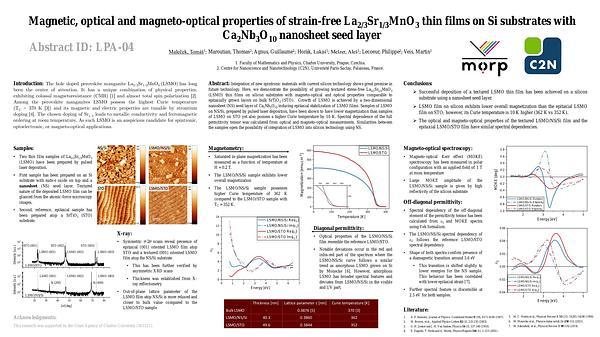Would you like to see your presentation here, made available to a global audience of researchers?
Add your own presentation or have us affordably record your next conference.
Rare earth/transition metal permanent magnets have gained significant interest due to their outstanding performance, which has made them key materials for many applications. The most well-known compounds Nd2Fe14B, SmCo5, and Sm2Co17 combine a large energy density, high Curie temperature, and a large magnetocrystalline anisotropy (MCA). Besides, SmCo5 exhibits the highest known uniaxial MCA1. Due to their importance, a detailed understanding of their hysteresis behavior has come into the focus of research2.
Since the extrinsic magnetic properties of magnetic materials depend on their complex defect and nanostructure, we follow the strategy to disentangle intrinsic and extrinsic properties as well as the effect of specific defects by investigating SmCo5 and Sm2Co17 phases in thin film model systems grown by molecular beam epitaxy (MBE).
The Sm-Co system, when grown as thin films in a certain parameter range, undergoes a phase decomposition into a nanocomposite of SmCo5 and Sm2Co17 phases. Due to the structural similarity of the two phases, it is challenging to discriminate their phase contributions. Extended X-ray absorption fine structure (EXAFS) analysis combined with transmission electron microscopy (TEM) allows the unambiguous quantification of the nano-domain phase decomposition in the thin films3.
In this work, we have studied the behavior of the magnetic anisotropy of Co and Sm using - for the first time, to our knowledge - angle-dependent X-ray magnetic circular dichroism (XMCD) at Sm M4,5 and Co L2,3 edges in 1.9 Tesla external applied field. SmCo5 and Sm2Co17 thin films have been grown onto Al2O3 substrates and pre-characterized by X-ray diffraction (XRD) and superconducting quantum interface device (SQUID). XMCD and X-ray absorption spectroscopy (XAS) gave access to element-specific information and have been complemented by detailed atomistic spin dynamics (ASD) calculations.
Element-specific hysteresis curves demonstrate strong coupling between Sm and Co, however, the spectroscopy indicates different saturation behavior. The XMCD spectra for the Sm M4,5 edges show surprisingly only a minor angle dependence. Using ASD simulations, we estimate the exchange field at the Sm site to be of the order of -200 T.
References:
1 K. J. Strnat & R. M. W. Strnat, J. Magn. Magn. Mater. 100, 36 (1991).
2 O. Gutfleisch et al., Adv. Mater. 23, 821 (2011).
3 S. Sharma et al., ACS Appl. Mater. Interfaces 13, 32415 (2021).
